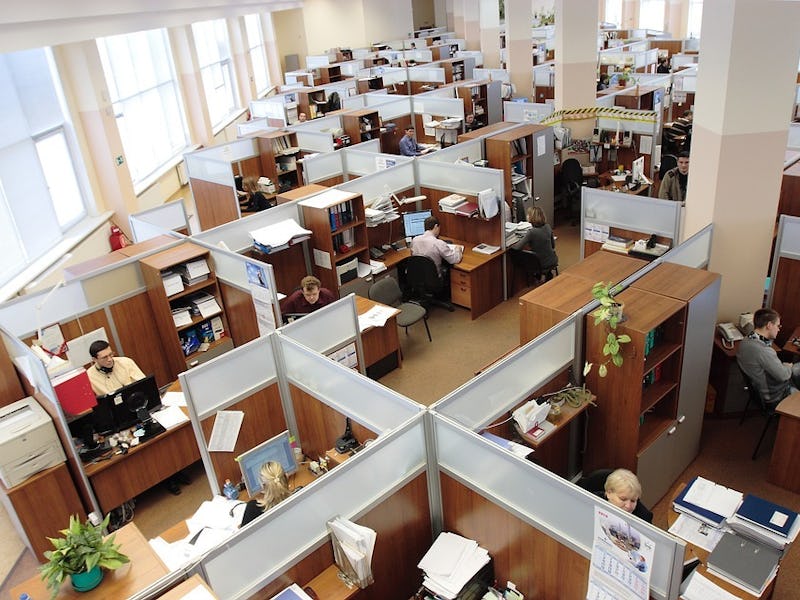Do You Work Next to a "Toxic" Person?
Changing the seating arrangement can bring in the big bucks -- but the effects won't last forever.

Office managers looking to up their game would be wise to take a hint from elementary school teachers, long purveyors of the seating chart. Placing the class nerd next to the laziest kid in school isn’t just something that worked in homeroom — it’s a technique that researchers are advising businesses to take advantage of today.
According to a new report by talent management company Cornerstone OnDemand and the Harvard Business School, “spatial management” — the strategic, physical placement of workers within an organization — is the key to success. Which means the trend of an open office floor plan just might become the norm, if future bosses are strategic about who sits next to who.
Rearranging chairs may seem like a solution too good to be true, but the researchers behind this report claim that’s really what it takes. What it really comes down to is what is described as the “spillover effect” — when the performance of one employee affects the performance of another.
“The source of spillover effects is a combination of inspiration and peer pressure from being in close physical proximity to high-performing workers,” the researchers found.
How to create a work environment that leads to success is by creating a symbiotic pairing or workers within a physical space — when this happens, organizational performance improves by 15 percent.
The researchers behind this report determined this by studying a technology company of 2,000 people over a two-year period. Throughout this time, the researchers conducted performance measures that considered how well the employee was doing in light of who they were physically surrounded by. This was the calculated spillover, described in the report as “an aggregate value of all the employee’s neighbors, weighted by distance.”
They determined that a productive scheme involves a maneuvering of workers different whose skills can be broken into three groups — those who excel in productivity, quality, or who are generalist blend of both. The researchers found that the company was the most successful when productive workers were placed next to the quality workers and the generalists were grouped together. This strategic seating added an estimated $1 million in annual profit for the organization.
Generalists are the most productive when they sit together.
On the flip side, spillover also occurred when “toxic employees” were placed near each other — workers who are straight-up harmful to an organization’s performance. The researchers found that when toxic employees are near each other, the probability that one of them will be fired is increased by 27 percent. This doesn’t mean that they should be fired — rather, the researchers argue that this demonstrates the power of a work environment and advise managers to strategically place their “toxic” workers next to generalists.
Physical space is described in the report as an “untapped resource” for enhanced performance — which may seem surprising at first when you consider that we humans have been working in physical space seemingly for forever. But what really matters is the changing dynamic of the physical space.
“I have found a surprising (to me) magnitude of effect on our performance coming from our office seating arrangements,” said co-author Dylan Minor to Inverse by email. “It is not until recent history that management has thought about how to better arrange it. . .The open office space movement is an example of this: making office layouts more open, hoping to force workers to be closer to each other, resulting in more collaboration.”
Minor believes that while spatial management has always been important, it will become increasingly used. Today, more and more offices are moving from the cubicle-maze floor plans made popular in the 1960s, towards open-office layouts. As of 2014, an estimated 70 percent of American offices had no or low partitions — a trend made by business titans like Google and American Express.
However, the chatter around open floor plans has moved from describing them as the “in vogue” movement to “destroying the workplace.” This largely comes down to the fact that while they create an inclusive space, open offices are also really distracting. Investigations into open offices have found that the majority of workers find them damaging to their productivity, creativity, and overall work satisfaction.
Will the trend of open offices reverse? Likely so, but until that happens, strategic seating via spatial management may be a quick fix that many offices need. But a fair warning: The researchers behind this report found that the effects of spillover only last for about two months if the less productive worker is later moved away from the highly productive worker. Peer pressure created by placing two types of employees together is a powerful force, but it doesn’t work unless your competition is sitting right next to you.